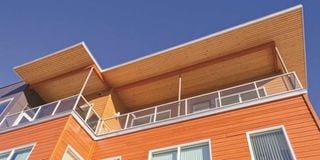Climate change and construction: What if wood is our saving grace?

A wooden building. Wood is both renewable and recyclable.
What you need to know:
- Our habitat, the earth, which we share with other living things is choking on carbon, and in return, it is choking us back.
- The construction and housing industry is responsible for at least 38 percent of the world’s carbon print.
In the Drowned World, a science fiction novel, the author, J.G Ballard, explores the idea of a world that is completely flooded in water due to climate change. Cities float on water and eventually sink. In the book, all the ice caps have melted, the sun is an ellipse and what’s left of the human population can only live on the North and South poles.
This storyline may seem far-fetched, and some would dismiss the author as an alarmist, but there is nothing unreal about melting ice caps, rising sea levels and buildings submerged in flood waters. It has been happening. Climate change is really happening. In the pacific, several small islands have already disappeared, and island nations such as Tuvalu and Kiribati are slowing getting swallowed by the erratic, unpredictable ocean tides. In fact, in 2014, Kiribati’s government bought a 5,460-acre piece of land in Fiji which would become a refuge when the tides eventually gobble up their coastal country.
Back home, in January 2021, a documentary aired by NTV revealed that lakes in Kenya are mysteriously rising and expanding. At the time of reporting, the shoreline in lake Turkana was at least 150 metres from the previous shoreline. And even then, the lake was seemingly settled and the wind calm. Non-aquatic trees were visibly floating on the water, evidence of a drowning village.
Residents narrated how they lived with the nightmare of floods, some even being forced to vacate their homes.It is ironic how most pollution and environmental degradation takes place in urban settings, yet those farthest from this setting are the ones that hurt the most.
On Monday, 4 October, the world, marked World Habitat Day, the theme ‘Accelerating urban action for a carbon-free world’. Our habitat, the earth, which we share with other living things is choking on carbon, and in return, it is choking us back. The construction and housing industry is responsible for at least 38 percent of the world’s carbon print.
In the past years, stakeholders have tried to reduce these numbers through green architecture, which entails safeguarding air, water and earth. It is a tough balance for construction experts as the demand for housing, especially in urbanised cities, is constantly increasing.
Sustainable Green Materials
On the backdrop of these facts and statistics, the Swedish Ambassador to Kenya, Caroline Vicini, hosted the Woodlife Sweden Exhibition on 27 to 29 September, at the Swedish Residence. The event sought to showcase wood as a sustainable, infinite resource, by displaying photographic exhibitions of different wood projects in Sweden - from schools to railway stations constructed using wood.
Wood is both renewable and recyclable. It is also lightweight, and construction blocks or logs can easily be cut to size on site. A house made of wood is sound proof and warmer. Environmentally, growing trees awaiting harvest capture carbon, thus cleaning the air, making wood the perfect solution for green architecture. But the big question is whether extensive use of wood in construction can be reconciled with sustainable forestry.
The event was therefore a meeting place where stakeholders in the construction, wood and forestry industries from Kenya and Sweden discussed the plausibility of wood for construction. During the launch, Ms Vicini spoke about her desire to host an event where stakeholders could initiate discussions on creativity around use of wood.
“I was born into the forest industry as my late father was the CEO of the Swedish forestry federation, one of the organisations behind this event,” she said.
Her home country, Sweden, has 70 percent forest cover, which has been achieved through policy. For every tree one cuts, one is required to plant at least two seedlings. Subsequently, over the past 100 years, the country has more than doubled its forest cover.
The timber industry in Sweden has also grown extensively as more building are constructed using the material. The country is home to some of the tallest wooden buildings in the world, the highest boasting of a whopping 20 floors.
Once upon a time, Kenya was dotted with houses made from wood, especially in the colder parts of the country, but these are slowly being replaced with stones obtained from quarrying. But wood is still a commonly used material in construction, especially when roofing, besides, most furniture in the country is made from wood.
However, illegal logging is depriving the country of at least 70,000 hectares of tree cover. These facts cause tension between construction and conservation.
The Chief conservatoire of Forests from the Kenya Forest Service, Julius Kamau, also present at the event, talked about the state agency’s mandate to sustainably conserve and protect all public forestry resources.
“In 2010, it became a constitutional obligation to grow the country’s tree cover to 10 percent, before or by 2030. But that target was moved from 2030 to 2022,” said Mr Kamau, further noting that forests play multi-faceted roles which include mitigation against climate change, socio-economic and cultural development.
“Out of the 2.59 million hectares of forest cover under the service, about 96 percent is meant for ecological purposes. This percentage is to be preserved and protected against utilisation. We have set aside about 150,000 hectares for commercialisation,” he explained.
Building from our reality
Sustainable forestry and its benefits seem to, however, be a constantly evolving discussion. When the Covid-19 pandemic hit the country, for instance, the conversation took an interesting turn. Kamau noted that many Kenyans sought refuge in the green spaces within the capital, and as every other entity was closing down, while forcing people to stay indoors, his department could not afford to lock out Kenyans from accessing parks, such as The Arboretum, Karura Forest, Ngong Hills and other green spaces.
No matter how much human beings evolve, they are innately drawn to nature, and being away from natural environments causes a significant amount of stress. Traditionally, villages were built with materials that came from the earth and went back to it. Think about mud huts with grass-thatched roofs, cabins and the iconic manyattas.
Perhaps, green architecture is bigger than wood. What if traditional materials, which have been neglected are more sustainable and greener?
“Looking at construction contextually, one of our biggest resources is earth, and we’ve been building with earth traditionally. What’s wrong with that. How can we change our mindset around traditional materials so that we begin to build out of our own reality?” poses Joy Mboya, the Executive Director of the Go-Down Arts Centre.
Innovation and Policy
She explains that it’s a question of mindset, further adding that it is important to interrogate what is being taught in schools of architecture and planning.
“I remember creating a group of architecture students in South Africa and they were focusing on building purely with brick. Brick is just burnt earth, and the students explored what we can do with all shapes, sizes and types of brick in design and construction,” she says.
Truly, we stopped exploring and innovating the materials that are within our reach, and instead, we are constantly focusing on new non-renewable materials. On the questions of wood, Ms Mboya points out, we have certain advantages we should consider.
For instance, Kenya has sun all year round, meaning we can grow trees comfortably. It is a sharp contrast from the Nordic countries which have less daylight. In Sweden for instance, there are days with less than eight hours of daylight, yet the country has achieved a higher percentage of tree cover. It seems policy is critical in increasing forest cover in Kenya.
For instance, how often does the average Kenyan plant a tree? There are laws and regulations around logging, but prevention of logging does not necessarily mean more trees will grow. As a natural material, Mboya says, wood is multi-sensory and its tactile features are pleasant.
Ask anyone, whether an artist, a carpenter or a contractor, they will say working with wood has a calming effect. Studies show that woodwork, reduces stress. It is warm to touch and has a proximity to nature. Then there is the natural grain. Different wood types have thousands of mysterious grain patterns which are beneficial in design.
Taking these benefits into account, wood has a chance in many of our personal spaces. But the question of cost still lingers for many developers, architects and other construction experts. Sandra Frank, co-founder and Marketing Director at Arvet, a Swedish construction company that only builds using wood, says that 15 years ago, it was perceived that the cost of constructing some parts with wood, such as the core of a building, was higher than when using other materials, say concrete and steel.
Wood buildings
However, she insists, that is just a small part of the big picture.
“You can build three timbers houses in the time it takes to build one concrete or steel house, using the same amount of labour,” she explains.
Cutting down on construction time and labour costs means the overall cost of construction goes down. Besides, wood construction no longer means using large chunks of wood. Arvet and many other developers around the world use Cross-Laminated Timber (CTL), which are pre-fabricated wooden blocks joined together using a special type of glue.
CTL has many benefits, which include minimal on-site wastage, easy to handle during construction, acoustic benefits and is flexible in case one needs to extend the building or re-model. Frank, above, notes that initially, people had fears and questions surrounding the durability of wood buildings, fire safety and how the wood behaves when exposed to water.
These doubts have however been quashed over the years as wood buildings prove to be sustainable. Some of the oldest wood buildings in the world are found in the Horyu-ji area in Japan, temples that date from the late 7th or early 8th century, making them some of the oldest surviving wooden buildings in the world.
Overall, whether developers in Kenya will explore wood as a green and sustainable construction material is a personal matter, however, there is need to look at the arising issues holistically. As noted by HE Vicini, “to actively combat climate change, wood and wood construction should enter the stage in urban planning and construction. Urbanisation is accelerating in Kenya,”.
What if wood is the answer to sustainable urbanisation. Can we truly sustain forestry while exploring the biodiversity of wood construction? What else, besides wood, should we explore as an alternative to polluters such as steel, cement and concrete?
People are becoming increasingly aware of climate change and the impact is undeniably real, therefore, any construction expert who wants to stay in the industry might have to go green as the demand for environmentally friendly spaces will be more popular in the near future.





